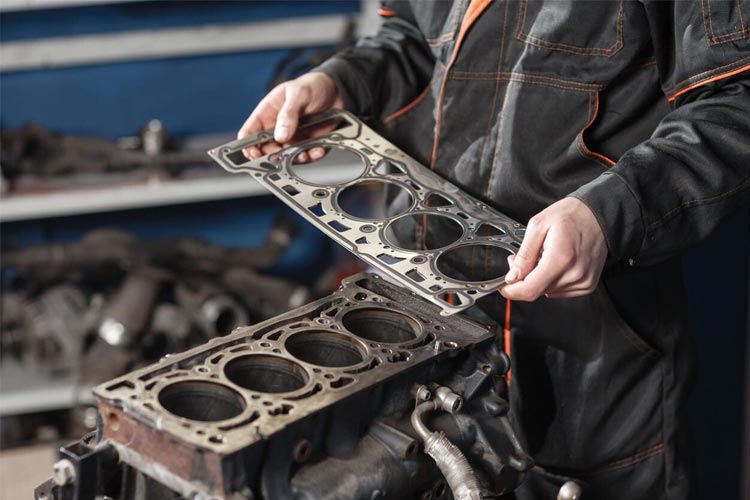Head Gasket is located in the combustion engine in any vehicle. It acts as a seal connecting the engine’s cylinder head and the engine block. In other words, it’s a barrier separating the combustion chambers from coolant jackets and oil channels.
They fail in their working ability when the head and the engine expand at different rates, and the gasket can’t seal the newly developed gap. The corrective measure should be taken on priority as they could cause serious issues and added expenses if ignored. Even a minor head gasket leak can cause the failure of your car engine.
Here we will try to provide a complete overview of head gasket faults, the signs to look for, and how much it costs to replace a blown head gasket. After that, if any mechanic tells you that your vehicle has a blown head gasket, ask them where it’s blown.
What Is A Head Gasket?
The head gasket’s purpose is to seal and keep the pressure created by the engine during the combustion of fuel in the machine itself.
The head gasket is a critical component beneath the bonnet positioned between the cylinder heads and the engine block. The main purpose of the engine head gas kit is to prevent any leakage of oil or coolant into the combustion chamber and seal the combusted gases.
It allows the vehicle engine to generate adequate energy to move the vehicle and ensures its internal combustion process is properly contained. It also directs the toxic gases through the exhaust system and stops them from leaving the chamber.
These gaskets of cars and other vehicles can also be used for many other purposes, as head gaskets are exposed to many different elements. These special-purpose head gaskets are made of multiple layers of steel interlinked with elastomer, which increases its durability and life cycle.
Why Is Head Gasket So Important?
Several factors make the head gasket such an integral internal combustion engine component. To understand clearly the head gasket, you must know the working and building of a combustion engine.
It’s a Pressure Job
The head gasket has to face extremes of pressure and temperature and is responsible for ensuring the pressure created by the spark plug ignition of gas fumes stays inside the combustion chamber. This job places heavy demands on it and means that it needs to be properly maintained.
The combustion chamber is composed of how the ignition produces heat and rapidly expanding gases that force the piston down and create the power to turn the motor and eventually move your vehicle.
For that important purpose combustion chamber houses the pistons, so maximum pressure is required to make sure the pistons remain firing properly. The Head gasket has to maintain a compression ratio within the combustion chamber of a car.
Act as a Barrier
The Head gasket also plays a very important role and acts as a passageway for motor oil and coolant. It separates oil passage and water passage through the block and cylinder head of engines. Bothe liquid serves a completely different purpose, so the two Liquids must stay separated.
Material of Construction of a Head Gasket
The Head gasket has to face a variety of different and often difficult conditions. The material of construction is very important in this regard must be able to withstand a range of temperatures and any reaction with any of the chemicals found in the oil, which is often specifically formulated to ensure the correct operation of many delicate – and expensive – components
It is a focus of much research, especially on the best materials from which to make them. Because its optimal performance can have a major bearing on the efficient working of any car’s engine, in this matter of concern, millions of pounds are spent every year by motor manufacturers.
They look to meet the ultimate goal of controlling extreme temperatures and ensuring that the seals that keep the various elements in their rightful places stay intact.
In this modern era of technology, the gaskets are made of Stainless steel rather than other metals like aluminum, as aluminum tends to expand more quickly. Aluminum has a high thermal expansion rate, causes rapid expansion of the head gasket, and weakens the integrity of the material, therefore making for a sub-optimal head gasket choice.
Apart from all that, fibers are also equally suitable. Many new chemical composites, such as silicone, neoprene, and plyometric resins, are commonly used.
Failure or Blown off of Head Gaskets
Understandably, any machinery part can undergo failure if not taken care of maintained properly. The possibility to blow off a head gasket happens due to the engine overheating, detonating, or using an old gasket.
The head gasket sits between these two engine areas, sealing the coolant passage, oil return passages, cylinders, and pistons. As it potentially fails, it leads to quick overheating. Not only is pressure affected, but the engine parts fail to get the correct amount of oil, water, and coolant mixture necessary for it.
Try not to drive whenever you are stuck in this problem because it can worsen the pre-caused damage. It would be best to look for immediate replacement and service rather than thrashing down. It leads to a massive risk of internal damage and causes a loss of compression inability problems.
Major causes of a Blown Head Gasket
The Major causes why a head gasket has blown off or leaked:
- Overheating is the primary cause of a blown head gasket. The Automobile manufacturer made a very high-capacity engine in their vehicle. Whenever the heat exceeds the normal level, the engine overheats and causes a blown head gasket.
- Age is another factor in blowing off the head gasket. Over time, head gaskets can damage and may not function properly to stop leaks and other issues. The only way is to replace it before facing any big trouble.
- A cracked Head or Block of the engine, which is happened due to overheating, may alter the sealing method of the head gasket, which may leak.
Signs of Head Gasket Failure
The most common and easily noticeable signs of a blown head gasket are as under.
Bubbles In Coolant Tank or the Radiator
Take ample notice if the bubbles are coming up in your vehicle’s radiator, like a fish tank or a child’s birthday party. That happened as the hot exhaust gases can leak into the cooling system, or coolant can leak into the cylinders and be burned off as steam. Either way, the result is an overheating engine.
That points towards a blown head gasket.
Oil Contamination
The blown gasket will lead the coolant to enter the engine oil; as a result, with anti-freeze contaminating the oil, any driving will quickly ruin the engine’s bearings. It’s a very easy and common symptom to identify either your engine head gasket has gone bad or not.
Visible Tailpipe Smoke Or White Smoke
Your engine’s gasket regulates the proper flow of the coolant throughout the engine. The gasket stops the coolant from entering the combustion chamber. The coolant enters the combustion chamber as the head gasket is blown or fails, mixing with fuel and burning.
A Blown off head gasket results in large clouds of sweet-smelling white smoke coming from the exhaust. This indication tends you the possibility of the leak from an oil passage to the cylinder, which would cause bluish smoke.
Urgently Done Steps If The Head Gasket Fails
Here is some important instruction if you feel the signs of failure are not strong enough.
- Visit your Mechanic: The best person to notice small signs and get to its nerve even when you feel the issue is not overriding.
- Oil replacement is necessary; filter and anti-freeze parts are required as they serve as maintenance parts and are prone to damage when the head gasket fails.
- Testing and skimming of the cylinder will be fruitful to you as sometimes the cylinder head can be repaired itself by first being pressure-tested to detect any cracking
Conclusion
Head gasket plays a vital part in the performing functionalities of oil and coolants, combustion chamber safety, and more. To replace the head gasket is a laborious job and expensive on the pocket because smart motor parts have to be exported in extreme cases.
Whenever you feel that you are experiencing some of these symptoms, we urge you not to wait. The average repair cost for a head gasket can range from $1200-2500; it’s a lot cheaper than having to replace an entire engine. So get on it!













